Broadway Park, at the intersection of 6th Avenue and the Cherry Creek, the most southwesterly corner of today’s La Alma Lincoln Park neighborhood, was the original home field of the Denver Bears. The prominent field also hosted the first decade of the Denver Post Tournament, which grew to a be a premier national baseball event. As with many of the stories I have uncovered for Across the Creek, this one started with an image, then a random reference, until a more complete picture of an earlier time came into focus. I ultimately discovered that after years of struggling to find a home field for a profitable baseball team for Denver, our neighborhood helped make that dream a reality for a time. Broadway Park served Denver’s “gods of sport” for about thirty years, before falling into disrepair and disuse. In the end, the lot was divided and sold off around 1926, and by today, is mostly absorbed by Denver Health and the Towne Place Suites.

Broadway and Cherry Creek 2015
For me, it all began while zooming In on the 1907 rendering of the city, when I saw a “Ball Park” next to the “County Hospital.” Months later, I read that the good folks that ran the Neighborhood House (on Galapago behind today’s West High) made use of nearby “Broadway Park” to raise money for expanding their sustaining services to Denver’s needy:
“The summer of 1913 exploded with Baseball Benefits. The Neighborhood House nine bravely took on other teams of the city such as East Denver, Elitch’s, and Sacred Heart. Society women served as usherettes. Musical programs were given before the games and during the intermission. Games were played in Broadway Park and a great time was had by all!!!” (Neighborhood House Scrapbooks).
Then, when I was collecting images for the Lost Landmarks Gallery and researching the Denver Circle RR post, the story really started coming together. First, it was an image of our neighborhood border at Cherry Creek that included an old ballpark. Jackpot!
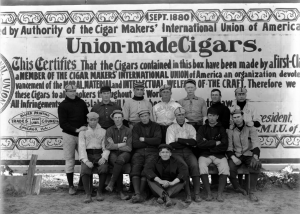
Members of the Denver Bears baseball team pose outdoors at a baseball field in Denver, Colorado. Some of the men wear uniforms. A cigar union sign is used as the backdrop. Courtesy History Colorado Collection CHS-B1369
Our amazing Denver Public Library’s Western History and Genealogy Collection offered a little more info with the caption, “View of Cherry Creek and Speer Boulevard in Denver, Colorado; shows spillways, concrete flood control walls, Union Park baseball field, and a Denver Tramway Corporation streetcar on the 7th (Seventh) Avenue bridge. “While Union-made Cigars were evidently a sponsor, the field was most commonly known as “Broadway Park,” with no other uses of “Union Park” found. I saw it referenced frequently as Broadway Park II, because the original Broadway Park was at Colfax, which itself had to be reconstructed once after a fire. Pictures from and captions describing “Merchants Park“ on South Broadway helped to confuse the story a bit, too.
In it’s lifetime, increased traffic around 6th, Broadway, and Speer lead to a reconfiguration of Broadway Park II as well.
![People crowd bleachers in an arena, probably for the Festival of Mountain and Plain, at the corner of Colfax and Broadway Streets, in Denver, Colorado; a marching band and horses are in the arena. The Colorado State Capitol building is in the distance. [between 1890 and 1910?] Courtesy DPL Western History Collection Z-6110](https://lincolnparkhistory.com/wp-content/uploads/2015/04/brodway-park-at-colfax-fest-of-mtn-and-plain.png?w=812&h=331)
People crowd bleachers in an arena, probably for the Festival of Mountain and Plain, at the corner of Colfax and Broadway Streets, in Denver, Colorado; a marching band and horses are in the arena. The Colorado State Capitol building is in the distance. [between 1890 and 1910?] Courtesy DPL Western History Collection Z-6110
When Denver was first taking shape in 1860, the game of “base ball” was gaining in popularity in the East. But, with the survival of the settlement uncertain and the Civil War dawning, it would take Denver about twenty years to successfully organize a professional team of its own. Sandlot games were very likely played from the start whenever enough men were assembled, however records of the first organized play began with Denver’s “better” set. With significant emphasis placed on a player’s character and social stature, 1862’s Colorado Baseball Club was a team with aristocratic airs. After several years of kicking about in the dust and heat, and an embarrassing defeat in 1867, Denver’s upper classes began to lose interest in playing ball themselves. Subsequent efforts to organize a gentlemanly league here required the inclusion of less “socially-active” participants to make things more interesting. Having seen the game elevated in the East, many boosters and businessmen saw success competing in “America’s pastime” as an opportunity to raise Denver’s prestige nationally.
![Members of the Denver Bears baseball team pose in a dugout in Broadway Park at 6th (Sixth) Avenue and Broadway in Denver, Colorado. They are identified as (left to right): Earnest "Kid" Mohler (2B), W. A. "Bill" Hickey (IF & OF), Jack Holland (IF & OF), Joe Tinker (IF), Eddie "Kid" Lewee (SS), Charlie Zeitz (OF), Henry Schmidt (P), and unknown. [1900] Courtesy History Colorado Collection CHS-B1456](https://lincolnparkhistory.com/wp-content/uploads/2015/04/members-of-the-denver-bears-1900.png?w=812&h=582)
Members of the Denver Bears baseball team pose in a dugout in Broadway Park at 6th (Sixth) Avenue and Broadway in Denver, Colorado. They are identified as (left to right): Earnest “Kid” Mohler (2B), W. A. “Bill” Hickey (IF & OF), Jack Holland (IF & OF), Joe Tinker (IF), Eddie “Kid” Lewee (SS), Charlie Zeitz (OF), Henry Schmidt (P), and unknown. [1900] Courtesy History Colorado Collection CHS-B1456

Members of the Denver Bears baseball team pose outdoors at a baseball field in Denver, Colorado. They are identified as: standing: Len “Dad” Shirk, Walter Price (P) Walter Bissell, unknown, “Old Hoss” Hausen (C), Happy “Klondike” Kane (P), J. H. Vizard (OF), Jack Holland (INF & OF). Middle: Pop Eyler (P), Dakin “Dusty” Miller (OF), Tom “Tacks” Parrott (P, OF, INF), Charley Kight (P) Charles “Princeton Charlie” Reilly (3B), Charlie Zeitz (OF), W. E. “Bill” Hickey (INF), Al Hickey (C). Front: Mons “Eddie” Webster (P), Walter “Wizard” Preston (CF), Jack Sullivan, Pearl “Casey” Barnes (INF), Clarence Leisenring, Mascot, Joe Tinker (2B), and W. E. Hurry McNeeley (P & INF). Courtesy History Colorado Collection CHS-B1427
In 1879, the “Denver Browns” became our first “professional” team when it competed in a series of games against Salt Lake City. Next, they represented us against the Colorado Red Springs and Leadville Blues in a 1882 three-team Colorado League. In 1883, prior to becoming Mayor, Wolfe Londoner began the Denver Baseball and Athletic Association, which held games at 32nd and Larimer Street, a short ride out of town on the horse car line. That field hosted teams from the region and served a number of local competitors. The “Athletics,” the “Denvers,” and the Rocky Mountain League would offer the best baseball in town for the next few years.
![Members of the Denver Bears play baseball at Broadway Park at Broadway and 6th (Sixth) Avenue in Denver, Colorado. Pearl "Casey" Barnes is at bat. [1900] Courtesy History Colorado Collection CHS-B1063](https://lincolnparkhistory.com/wp-content/uploads/2015/04/broadway-park-1900.jpg?w=812&h=448)
Members of the Denver Bears play baseball at Broadway Park at Broadway and 6th (Sixth) Avenue in Denver, Colorado. Pearl “Casey” Barnes is at bat. [1900] Courtesy History Colorado Collection CHS-B1063
The league would experience a few periods of disorganization, but interest in the game survived. Professional ball repeatedly tried to reorganize itself and Denver emerged as the “Colts” and/or the “Trojans” in 1889. The season was most remarkable for games played at the first Broadway Park at Colfax.
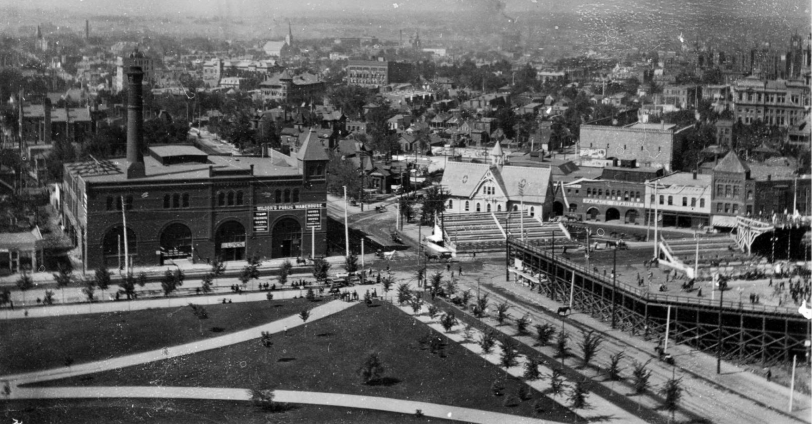
First Broadway Baseball Park from atop Denver Capitol Building, overlooking Colfax and Broadway. Courtesy DPL Western History Collection X-22577
Among the players on the 1886 “Denvers” team was George “White Wings “Tebeau. He was known for his speed, grace, and well-groomed appearance. As team owner, his his reputation for thrift prompted a columnist to write that he was so cheap ” that he squeezed pennies until the Indian [cried] in pain.” He was also called a “father of Denver baseball,” and more significant for La Alma Lincoln Park, he brought professional minor league baseball to Broadway Park II in 1900.
Home to “Gods of Sport” for 30 years
The arena was actually first built for an Association of American Wheelmen in 1893, and also hosted many bicycle races, college football, coursing, and other local athletic demonstrations. The park was centrally located and connected to the city by nearby Denver Circle trains, and then the Tramway Co. trolleys.Tebeau’s determination to see professional baseball in Denver and his purchase of Broadway Park would make it Denver’s own “field of dreams” for the first decades of the twentieth century.
![Broadway Park II. Men and women perform an exercise demonstration at the athletic field in Broadway Park, West 6th (Sixth) Avenue and Broadway in Denver, Colorado. A man stands on a wooden elevated platform and oversees the athletes. The women, in bloomers, hold Indian clubs, and march with men in suits, ties and cowboy hats who carry exercise sticks. Men and women stand near the field or sit on a fence or on bleachers. Painted signs read: "Dr. Bicycles Athletic Goods, fully guaranteed" "Earle, a good throw throws it right" and "Attention batsmen, hit this sign and get 100 US 5 [cents] Ci[gars]." [between 1900 and 1920?] Courtesy DPL Western History Collection Z-2725](https://lincolnparkhistory.com/wp-content/uploads/2015/04/exercise-demonstration-at-athletic-field-6th-and-broadway.png?w=812&h=289)
Broadway Park II. Men and women perform an exercise demonstration at the athletic field in Broadway Park, West 6th (Sixth) Avenue and Broadway in Denver, Colorado. A man stands on a wooden elevated platform and oversees the athletes. The women, in bloomers, hold Indian clubs, and march with men in suits, ties and cowboy hats who carry exercise sticks. Men and women stand near the field or sit on a fence or on bleachers. Painted signs read: “Dr. Bicycles Athletic Goods, fully guaranteed” “Earle, a good throw throws it right” and “Attention batsmen, hit this sign and get 100 US 5 [cents] Ci[gars].” [between 1900 and 1920?] Courtesy DPL Western History Collection Z-2725
Tebeau was a baseball veteran that always believed that there was market here for the game, but knew his customers would only pay to watch quality players. He scouted hard for talent and kept payroll down by paying younger players less than veterans demanded. After an early fire at his park, he saw opportunity to improve business with a remodel, adding box seats for families with individual chairs. He fostered a “big league” atmosphere by adding a player clubhouse equipped with showers. Admission prices were initially set at forty cents for general admission and sixty-five for the shaded grandstand seating, but were adjusted to 30 and 50 cents when attendance dropped below 1000 after the first few games. By the time the team was racing toward the Western League Championship pennant, crowds at Broadway Park reached about 4000 spectators.

Panorama View of Grand Stand and Baseball Enthusiasts at the Opening Game of the Western League Season, Broadway Park 1910. Courtesy DPL Western History Collection C352.078883 D4373mu
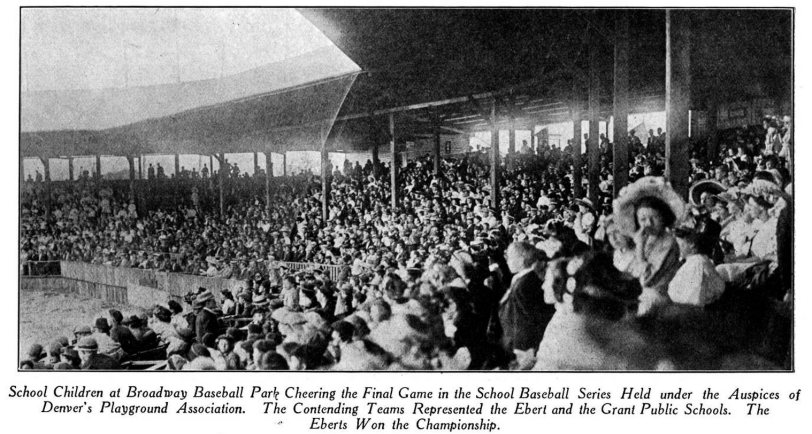
Fans enjoy the School Baseball Series at Broadway Park II. From Denver Municipal Facts 1909 June 19 p12. Courtesy DPL Western History Collection C352.078883 D4373mu.
Tebeau’s winning 1900 team was actually called the “Skyscrapers” and/or “Roughriders.” It wasn’t until 1901, after he sold the team for the first time, was it referred to as the “Grizzlies” and/or “Cubs.” That year marks the beginning of President Roosevelt’s administration, and the team was also written up as the “Teddy Bears.” The names “Grizzlies” and “Bears” were used almost interchangeably for the team often connected to Tebeau, and always with the Western League, until going into hibernation in 1917.
It must be noted that in 1911, President Taft helped honor the team at Broadway Park for the first of three consecutive pennant wins under manager Jack Hendricks.
Starting in 1915, the Denver Post Tournament was hosted by Broadway Park for 10 of the first 11 years in existence. The tournament began as a local, ten team exposition, and grew to be known as “The Little World Series” by its final year in 1947.
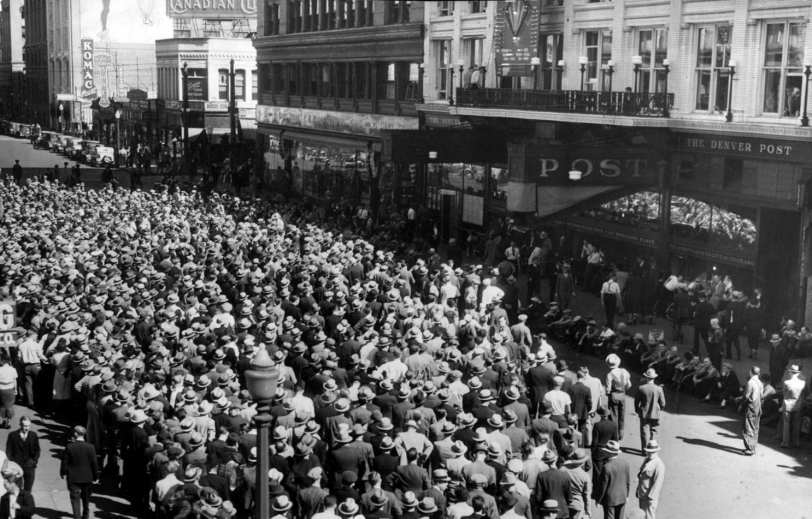
Whatta Game! People crowd Champa Street by the Denver Post newspaper headquarters in downtown Denver, Colorado, to listen to a baseball game. An electric scoreboard is above storefronts on a balcony on the Denver Post building; canopy reads: “Post.” Business signs read: “Komac” and “Canadian Club.” Title from newspaper clipping attached to back of photoprint; also reads: “Just a portion of the huge crowd that gathered in front of The Post Wednesday and thrilled, pitch by pitch, to the Cub’s victory over the Tigers in the opening game of the World Series. Thursday, and all remaining days of the series, these games will be played for you on The Post scoreboard.” 1935 October 3. Courtesy DPL Western History CollectionX-28817
The full history of Denver’s struggle to establish viable teams in the West is filled with player poaching, blacklisting, and crippling disorganization. To keep people in seats, Tebeau invited the locally sponsored and semi-pro teams to bat it out in the park when the Bears weren’t playing. He always knew that fans would pay for quality baseball, and he had a knack for finding it. He had his hand in some part of the game until his death in 1923. The Tebeau estate was compelled to sell the lots off in 1926 and grand hopes of renovations to the prominent corner never really came to fruition. The Art Deco/Streamline inspired Hirschfeld Press building that was later incorporated into the Marriott hotel that exists today, wasn’t built until 1949.
Sources
Thanks, as always, Denver Public Library, 5th Floor, Western History Collection and History Colorado
For more, Check out this Denver Bears post from the DPL blog and PurpleRow.com for Baseball Before Coors Field: A tour of Denver’s Historic Baseball Sites
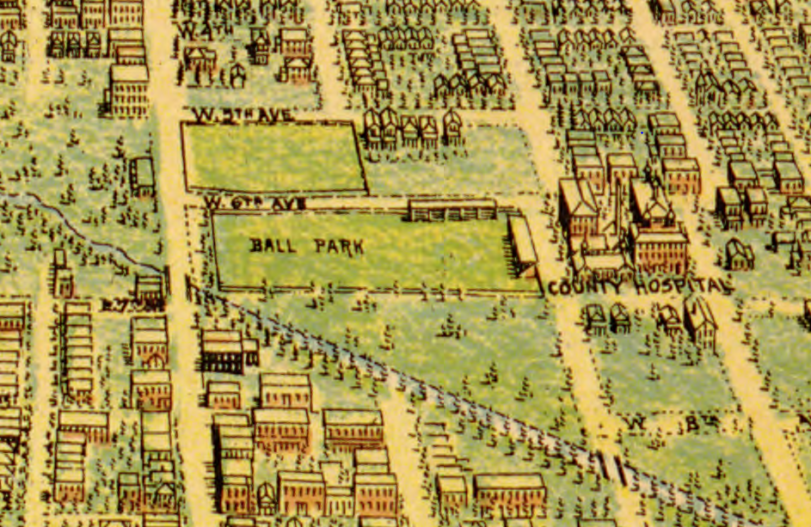
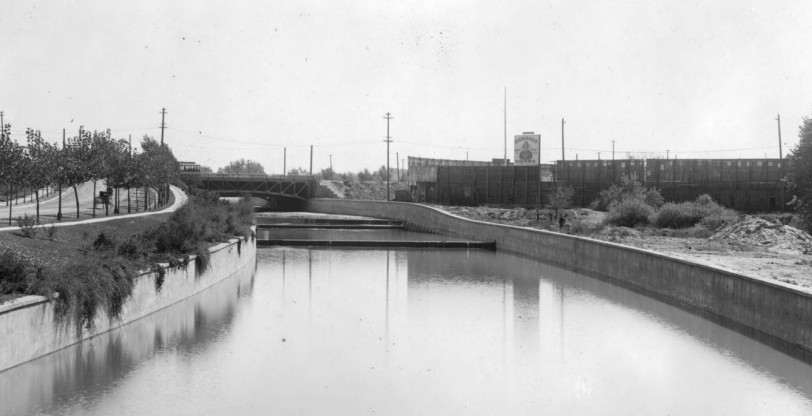
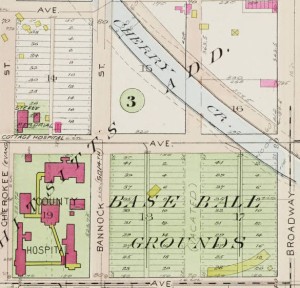
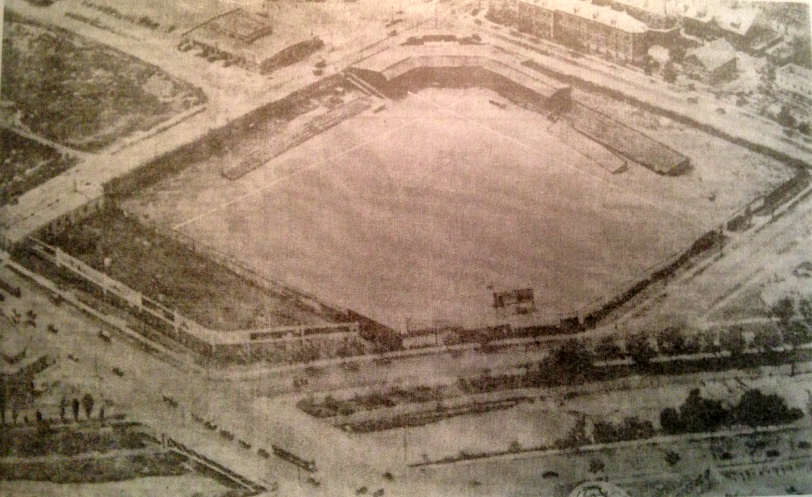
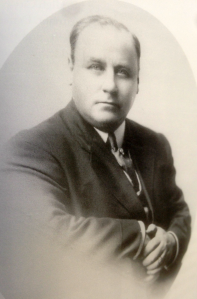


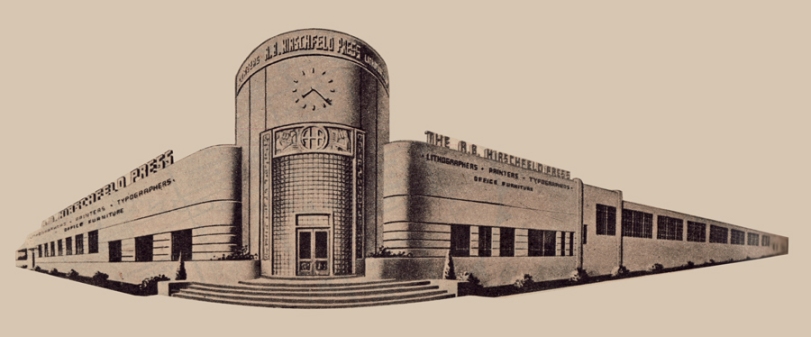
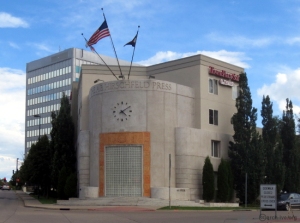
Thank you so much for this great article. It is fascinating.
LikeLike
Thanks! 🙂 I’m not sure how to attach an image here (it’s on my hard drive now) but I’d love for you to take a look! I can read a few names though, 1) Pete Peterson and 2) Porky Burke…
LikeLike
Hi! I just came across your site and was wondering if you could point me in the right direction? 🙂
I purchased a picture for the frame at a second hand shop and when I removed the print, there was a cool picture of baseball team from Denver! In doing a quick google, I found that they were referred to as The Denver Bears. I’m uncertain of the year but the team members in picture have their names written on the back. Very old and faded and written in pencil it’s hard to clearly determine who they are. Can you suggest a route I can take to solve the mystery? 🙂 Please let me know whenever you can! Thanks!
LikeLike
What a fun find! One of the Denver baseball books I have has a ton of team shots- probably more on the 5th floor of the Denver public library, as well as their image collection online.
http://cdm16079.contentdm.oclc.org/cdm/search/searchterm/photograph!Denver%20bears!denver%20(colo.)%20–%201900-1910.%3B%20baseball%20players%20–%20colorado%20–%20denver%20–%201900-1910.%3B%20denver%20bears%20(baseball%20team)/field/formatb!all!subjec/mode/all!all!all/conn/and!and!and/order/title/ad/asc
So you might compare it to some of those to nail down the year. I am happy to help look if you want to share an image
LikeLike